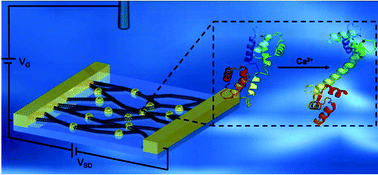Probing Ca2+-induced conformational change of calmodulin with gold nanoparticle-decorated single-walled carbon nanotube field-effect transistors†
Abstract
Nanomaterials are ideal for electrochemical biosensors, with their nanoscale dimensions enabling the sensitive probing of biomolecular interactions. In this study, we compare field-effect transistors (FET) comprised of unsorted (un-) and semiconducting-enriched (sc-) single-walled carbon nanotubes (SWCNTs). un-SWCNTs have both metallic and semiconducting SWCNTs in the ensemble, while sc-SWCNTs have a >99.9% purity of semiconducting nanotubes. Both SWCNT FET devices were decorated with gold nanoparticles (AuNPs) and were then employed in investigating the Ca2+-induced conformational change of calmodulin (CaM) – a vital process in calcium signal transduction in the human body. Different biosensing behavior was observed from FET characteristics of the two types of SWCNTs, with sc-SWCNT FET devices displaying better sensing performance with a dynamic range from 10−15 M to 10−13 M Ca2+, and a lower limit of detection at 10−15 M Ca2+.



 Please wait while we load your content...
Please wait while we load your content...
